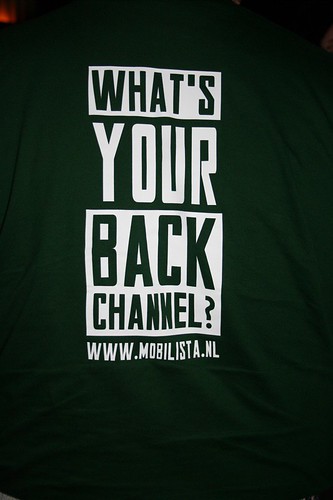 A DM Tweet today caused me to go and look and see what resources I’ve posted on the blog about back channel work. For me, back channel refers to a number of things that fall into two broad categories:
A DM Tweet today caused me to go and look and see what resources I’ve posted on the blog about back channel work. For me, back channel refers to a number of things that fall into two broad categories:
- back channel as a text based channel used at live events for a way for participants to be in the conversation and potentially share it out to the wider world, and
- back channel facilitation in online groups where you make a decision to address issues privately and not “in front” of the whole group.
After a bit of searching, here is what I came up with.
Conference Back Channel
- Backchannel Resources (including a link to Howard Rheingold’s)
- Raising the bar at online events
- Some backchannel ideas buried in this broader post on events.
- What live chat back channel looks like
- Clay Shirkey on back channels at conferences
- Chat as telephone call back channel
- Getting to know someone through back channel chat
- Civility and the back channel (the gems are in the comments)
- Jon Garfunkle on the backchannel at conferences (from a blog post comment)
- Barry Dahl talks about the “back channel” at conferences
- Liz Lawley on Digital back channels (referenced in one of my posts)
Community Back Channel
- Interventions: in front or behind the curtain – an older piece focused on facilitation aspects.
- Hopping between note taking and back channel conversations
- Blogs and Community (has as section on backchannel)
- Jim Benson on the Backchannel at work (from a blog comment)
- Lots of links at the bottom of this post on telephone call facilitation with much emphasis on back channel
Do you have any great back channel tips or resources to share?
Photo Credit: Flickr creative commons from Deb Schultz – thanks, Deb!
I think of backchannels either in the linguistic sense – utterances like “yah”, “uh-huh” etc that indicate the listener is participating or the level of agreement – or the political connotation – an unofficial communication in the background that can preserve deniability.
These can take interesting flavors in digital form – I first encountered them academically in my HCI department where a new member was an expert in analyzing the backchannel communications that went on in MUDS.
We built some prototypes for analyzing digital backchannel where the mainchannel (or forechannel) was audio or even video .. sort of what everyone does IM anyway.
It is a remarkably rich area. I remember a neat talk by Wendy Kellogg on the subject
Hi Nancy,
I just published a blog post about The Dark Side of Digital Backchannels in Shared Physical Spaces (http://bit.ly/dark-side-of-twitter) yesterday, spanning some experiences over the past 5 years or so, and came across your post in looking for information related to a comment someone else posted.
I am embarrassed to realize how much of the conversation I’d been missing out on – the only intersection in our sets was Liz Lawley – but as my own post was already [overly?] long, I simply inserted a reference to your extensive lists of great resources.
Thanks for compiling these lists, and I’m glad to have at least stumbled upon these resources late (vs. not at all). I’m sure I’ll be circling back to some of these themes again.
Joe.
Joe, I’m reading this at 5:30 am in Rome and thinking, FABULOUS POST – everyone should read it. You are weaving together so many threads on the issue and as I read I kept nodding and nodding in recognition. As I begin a week of F2F facilitation, with a group that does not (as far as I know) use the back channel during a F2F meeting (maybe there is some poetic justice in the fact that the room’s promised wifi is not working so far), I also wonder about the complicated dynamics of back channel to in room F2F work meetings (not conferences.) (wow, lots of parenthesis in my response this morning!)
Offline backchannel has been a mostly implicit part of our lives. We just couldn’t see/hear it for the most part. Can you imagine looking back and being able to see/hear it? I”m not sure I’m strong enough. 😉
More later after I return home. But a huge thanks for the article.
I wanted to tell you, I do believe there is a trouble with the RSS, it isnt working properly in my Feed reader. It only began happening a few days ago, did you change anything on the webpage?